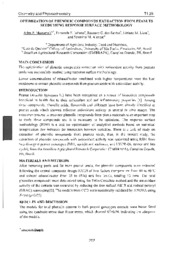Optimization of phenolic compounds extraction from peanuts seeds using response surface methodology.
Optimization of phenolic compounds extraction from peanuts seeds using response surface methodology.
Author(s): MASSARIOLI, A. P.; JULIANO, F. F.; SANTOS, R. C. dos; ALENCAR, S. M.
Summary: Peanut (Arachis hypogaea L.) have been recognized as a source of bioactives compounds beneficiai to health due to their antioxidant and anti-inflammatory properties [I]. Among these compounds, phenolic acids, Oavonoids and stilbenes have been already identified in peanut seeds which showed effective antiox idant activity in several in vitro assays. The extraction process to recovery phenolic compounds from p1ants materiais is an important step to study these compounds and it is necessary to be optimized. The response surface methodology (RSM) is a too1 for optimization of analytical methods based on statistical interpretation that indicates the interaction between variables. There is a lack of study on extraction of phenolic compounds from peanuts seeds, thus, in the presem study, the extraction of phenolic compounds with antioxidant activity was optimized using RSM from two divergent peanut genotypes (BR I, upright and earliness, and LViPE-06, runner and late cycle), from the Brazilian Agricultural Research Corporation (EMBRAPA), Campina Grande, PB, Brazi!.
Publication year: 2016
Types of publication: Paper in annals and proceedings
Unit: Embrapa Cotton
Observation
Some of Embrapa's publications are published as ePub files. To read them, use or download one of the following free software options to your computer or mobile device. Android: Google Play Books; IOS: iBooks; Windows and Linux: Calibre.
Access other publications
Access the Agricultural Research Database (BDPA) to consult Embrapa's full library collection and records.
Visit Embrapa Bookstore to purchase books and other publications sold by Embrapa.

